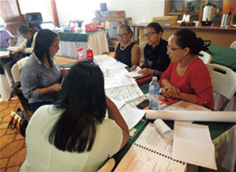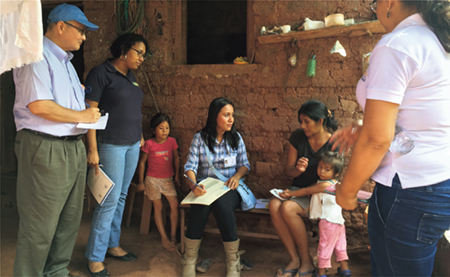Stories from the Field 10
Aiming to Improve Maternal and Child Health
– Strengthening the Healthcare Service System in Honduras
Honduras has one of the highest poverty rates*1 of any Latin American country, while mortality rate for children under 5 at 22.2 per 1,000 live birth in 2013, and the maternal mortality rate at 129 per 100, 000 live birth in 2015.*2
In Latin America, recently, the model of primary health care (PHC) has become mainstream, where local residents aim to address health care issues for themselves by thinking and taking action on essential medical health services. In Honduras, a National Health Model was formulated based on the ideas of PHC. This model proposes for the provision of inclusive healthcare services as a top priority in which family health teams consisting of doctors and nurses provide home visiting clinic.
However, Honduras requested technical assistance from Japan as it did not have the know-how to standardize such healthcare services. Following this request, in 2013 Japan selected Lempira Department, an area that is well governed locally but has one of the high poverty rates in the country, and El Paraíso Department, an area with poor local governance but an average health service network, as two unique pilot areas to implement healthcare services under the National Health Model, with a focus on maternal and child health (project to continue until 2018).

Instructor training for a family health team (Photo: Takaharu Ikeda)
This project aims to establish a system based on PHC to enable residents and the local governments to work together in addressing local healthcare issues, which will result in continued improvement of people's health. Also, in this process, it aims to strengthen the ability of family health teams, which serve as the core of service improvement.
Since the formulation of the National Health Model in Honduras, a survey targeting all households has been continually implemented in order to assess the health status of the residents. The results of the survey have surfaced a number of challenges in healthcare. For example, very few pregnant women attend prenatal check-ups, or many of those who actually attended the check-up had waited for many months after becoming pregnant. For such occasions, there were many cases where it was too late for pregnant women although they were rushed to a medical facility at the last minute under a dangerous condition without knowing their actual due date.

Mr. Ikeda teaching supervision methods for family health surveys (Photo: Takaharu Ikeda)
Mr. Takaharu Ikeda of IC Net Limited, who is working at the project site for the project under contract, describes his experience as follows. “First of all, I started by promoting the importance of getting an early prenatal check-up among the local residents. I explained the reasoning behind getting check-ups during early pregnancy as well as the purpose of knowing one's due date, by providing examples in detail.” Through these efforts conducted continuously as part of the family health team, the rates of seeking a prenatal check-up and birthing at the medical facility have gone up remarkably in the two pilot areas.
In addition, the portable ultrasonic diagnostic device brought from Japan serves a great contribution during the activities of the family health team. This device allows a doctor to see inside a person's body. A portable, compact version of the device made possible with Japanese technology was very effective in rural areas without medical facilities, as pregnant women can see how their babies are growing inside their uterus without leaving their village.
Furthermore, the device can also accurately calculate the due date of a delivery to avoid endangering a mother and her baby due to improper record keeping, and the device can detect abnormalities earlier. Additionally, the family health team shares the diagnostic data and strengthens collaboration to get appropriate advice from them with specialists at hospitals, making it possible to provide specialized diagnosis and early treatment. Moreover, through home visits in person to provide check-ups, the home health team gained increased trust in healthcare among the residents.
According to Mr. Ikeda, “Since I participated in the project, I tried to make sure local people acquire the knowledge and skills needed to continue the project independently. At first, they were just observers who cooperate with us, Japanese people. However, as I explained that we were not here to do as we like, but rather to help local people to carry out their duties based on the National Heath Model, they understood the purpose of this project, and were delighted.”
The results of the project, guidelines and details of the training were shared with the Government of Honduras. Also, the same materials are utilized in lectures and training on family healthcare in national universities. By sharing the knowledge and experience with current students, future graduates of medical schools, and others, it is expected that the know-how in improving healthcare system can be utilized in other regions in the future.
*1 Statistics used by the World Bank to estimate poverty level corresponding to the socio-economic environment by country. If the income per household member falls below the sum of cost of food needed to meet their calorie requirement (food poverty line) and the cost of minimal required non-food items to fulfill their basic needs (non-food poverty line), then the individual is considered to be in poverty.
*2 Source: Millennium Development Indicators (The Official United Nations Site for the MDG Indicators)
<< Previous Page Next Page >>
Main Text | Statistics and Reference Materials | Stories from the Field | Master Techniques from Japan to the World | ODA Topics
